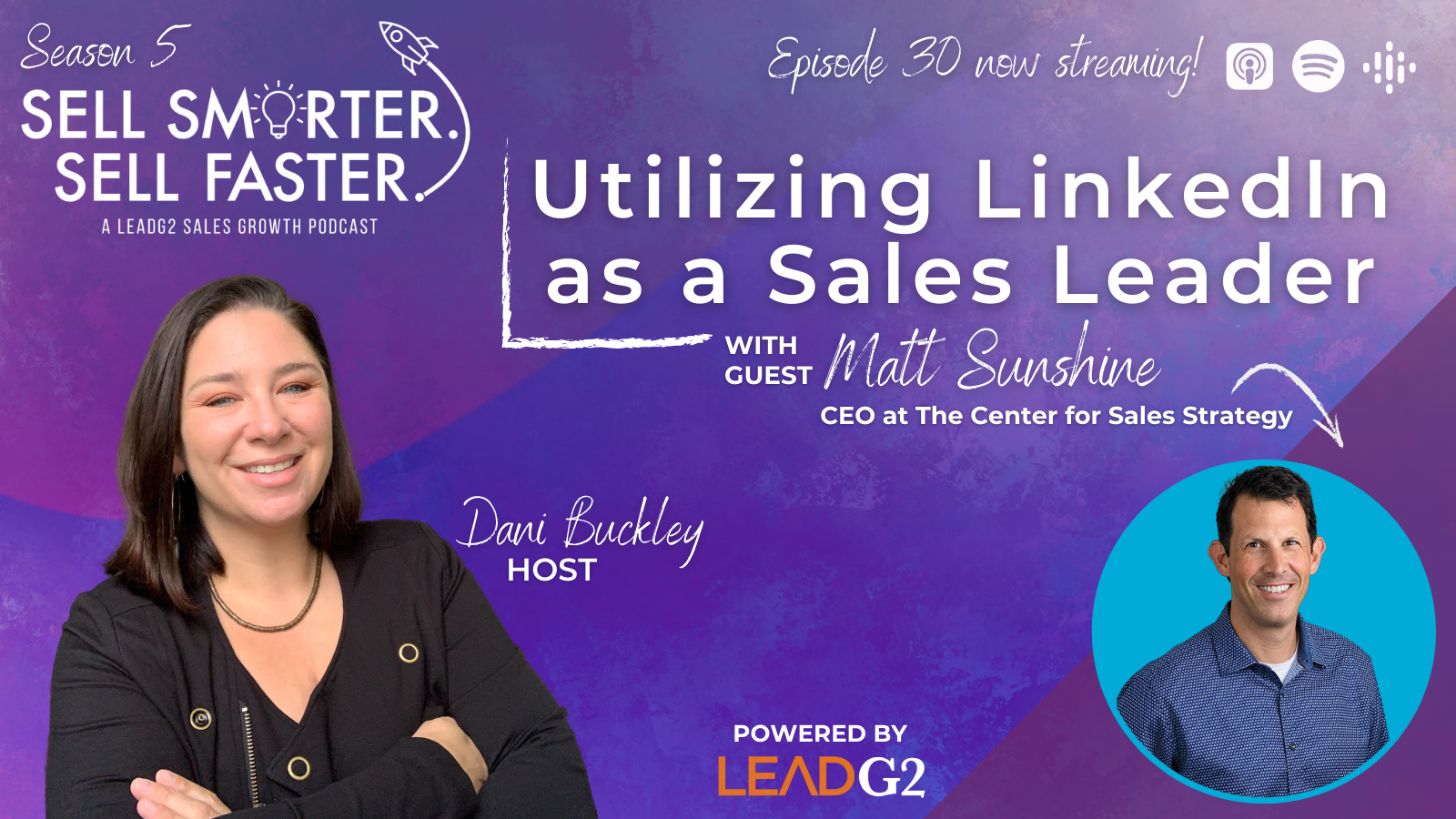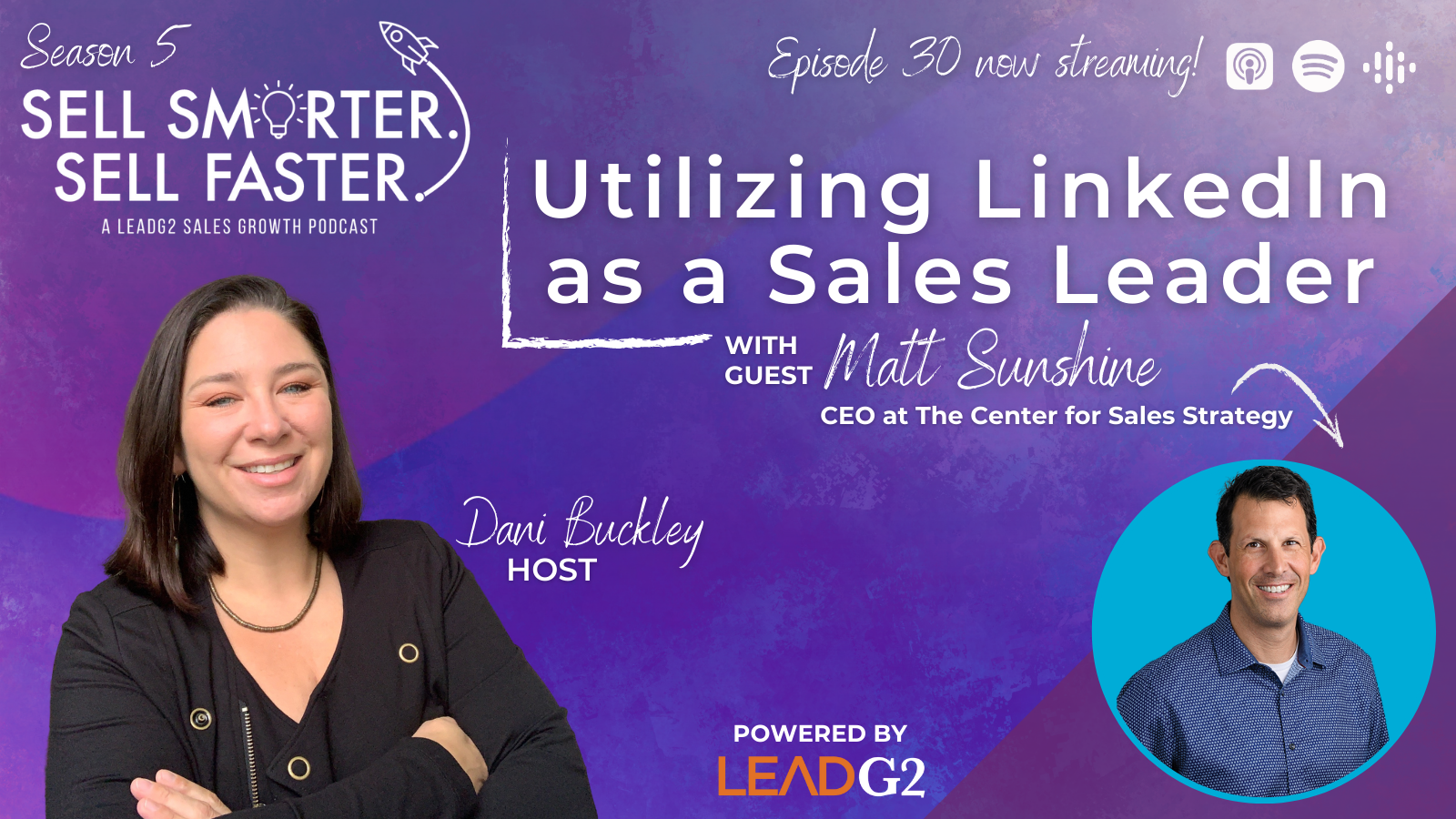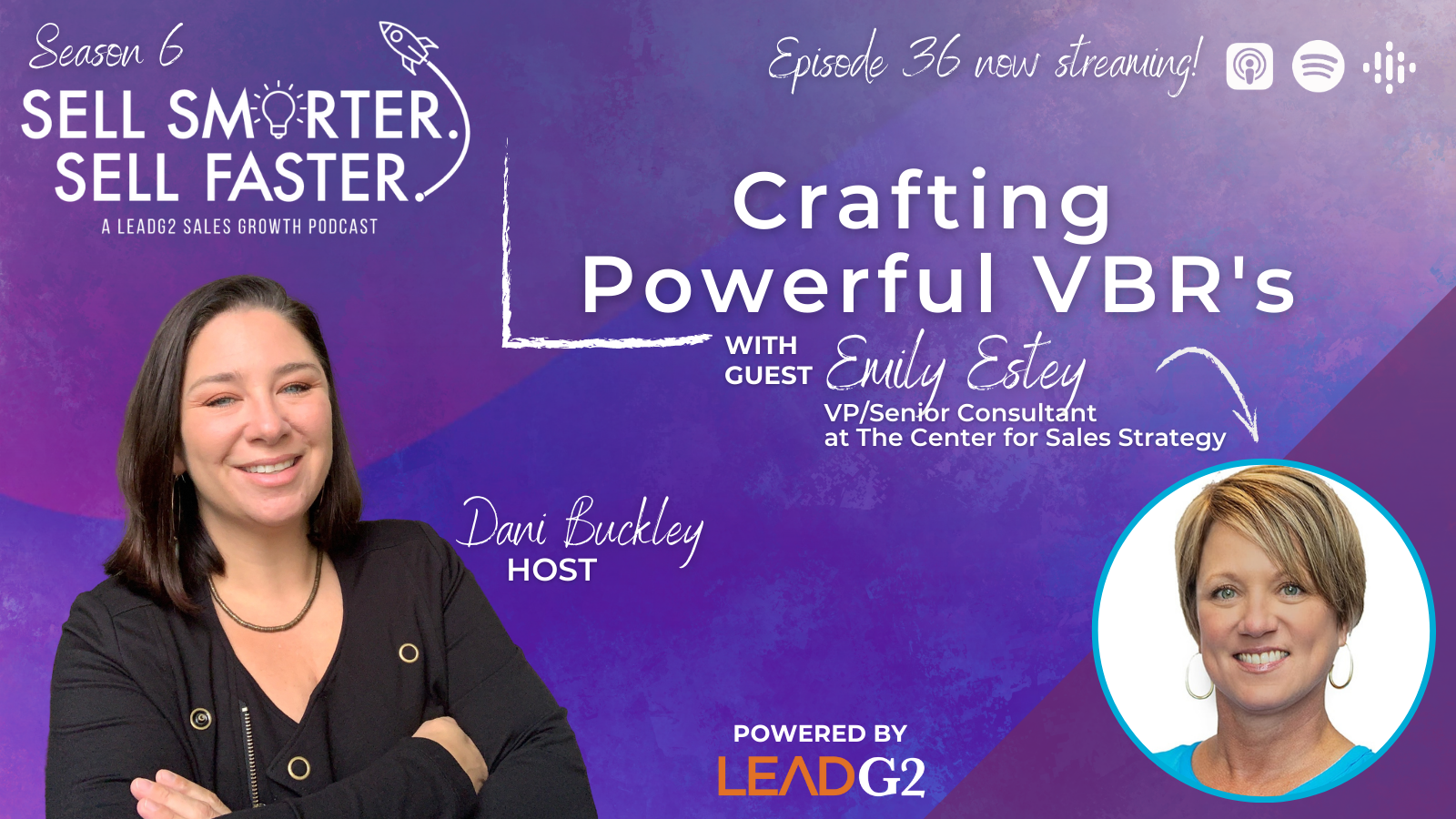1 min read
Navigating ABM as a Sales Manager with Elissa Nauful
In this episode, we’re diving into Account-Based Marketing (or ABM), asking questions like: Why is ABM a strategy worth the consideration of sales...


In this episode, we’re discussing how to best utilize LinkedIn to boost your thought leadership efforts. Why is it important for sales leaders to develop their professional reputation on LinkedIn? What are some best practices and common mistakes leaders are making? What types of posts work well, and how often should you post them?
Joining Dani to answer those questions and so many more is Matt Sunshine, CEO of The Center for Sales Strategy.
Matt brings up some great pieces of insight, like:
Why it’s important to build thought leadership on LinkedIn not to get more leads but to simply be helpful
How closing the “knowing” and “doing” gap can mean winning half the battle
As well as tips and best practices for how to do this consistently and effectively

“Why is it important for business and sales leaders to develop their professional reputation on LinkedIn?” Dani asks. “What does that look like?”
“So let me say this,” Matt says. “What you do or don't do, that’s your reputation, right?
“I mean, not ever posting anything on LinkedIn, not commenting, not liking, not sharing, not doing any of that is your reputation. ‘Oh, you're that person that doesn't do that.’
“You know, if being a thought leader in your job is important, then you need to be a thought leader. And that means that you need to share your opinions. You need to disagree when it's appropriate to disagree. You need to add weight when you can.
“I think it's really important as a professional...and do it not to get leads; that's the wrong reason to do this. Not to get leads but to be helpful and to truly be that thought leader.
“So, I think it's super important because some roles have that responsibility, but I also think you're kidding yourself if you say, ‘Oh, I'm just not going to participate. I'm not going to do that.’ Because the moment you do that, that is your brand. You've just created a brand for yourself. So, remember that.”
“Yeah,” Dani says. “I love that you always bring it back to, ‘it's about being helpful.’ That's what being a thought leader really should be. So I appreciate that.
“It's my belief that it all starts with your profile, right?” Dani says. “You’ve got to get that right first.
“So, I'm curious if you have any tips or best practices to share, [when it comes to] just making a profile on LinkedIn that's going to help you be seen as a thought leader, going to help you connect with people. What do you think?”
“You know, I think the profile's important because sooner or later, people you don't know are going to check you out, right? And that is their first impression of you.
“I think that the way people use LinkedIn is they see what you comment on, or they see something that you've done, or maybe they heard you speak somewhere, or your name bubbled up from someone, so they check you out. And what does ‘check you out ‘mean?
‘Check you out’ means I will look at your summary. I'm going to look at where you've worked. I'm going to look at what mutual connections we have. And then I might scroll down and see do you have any recommendations maybe?
But my first impression will be, ‘What does that profile summary say?’
Oh, and the profile picture. Maybe more than what the summary says, it's going to be that picture. It's like, ‘Oh that person looks like I want to hang out with them; I want to follow them.’
“I have lots of thoughts and opinions that I gladly share with everyone that will allow me to, whether in a blog or video or on social media. But one thing that I find really, really hard to do is to write a summary about myself. It is truly the hardest thing in the world.
“So what I would do, and what I did do, is I made a list of all the things that I would want to include in my summary about me, all the things that I thought, ‘you know what, if someone was checking me out, these are the things I would want them to know about me.’ And then I went to someone who I know and trust, and I said, ‘Hey, can you write my summary for me? Because I'm having a really hard time writing about myself.’
“That works. I also know someone who recently, and I thought their profile looked absolutely amazing, so she put it in ChatGPT. She said, ‘Write me a LinkedIn summary based on these attributes that I think I have. It really did a good job. She had to edit, of course, but it was a great start.
“So again, I think the benefit of that is having a third party write about yourself. I'm not good at writing about myself.
“I love that,” Dani says. “And I'll add one thing that I always think is nice and helpful to think about for that summary. Add something that talks about how you help people, how your business helps people, and how you help people, right?
“I think sometimes I see some folks’ [summaries], and they’re all about like, ‘This is why I'm great, and this is what I do.’
“But make sure the language is actually speaking to what makes you helpful. What problems do you help solve?”
“I think that's exactly right,” Matt says. That's a good clarification. When I say I list the attributes, that doesn't mean like, ‘Matt does this, and Matt's accomplished this.’
I mean, you can scroll down and see my resume if you want to know all those things or see other experiences. What I am talking about specifically is problems that we solve, how I'm helpful.”
Dani says, “So, let's talk about actually growing your LinkedIn network.
“Because if you are publishing a bunch of great stuff, but you're not connected to anybody, it doesn't really matter. What are some habits or practices that you have to keep growing that LinkedIn network? Are there things that maybe you do all the time just to keep making sure it's alive and well and healthy?”
“I think in order to grow, it's kind of like when I talk to people about how to get referrals,” Matt says. “I always say, ‘You have to give referrals to get referrals.’ So, I think in order to get people to follow you and to connect with you, you have to connect with them.
“I'm pretty intentional, right? I think about who I want to connect with. I think about who I'm finding on LinkedIn that I kind of follow, and I read what they write or I comment on their posts. I'm liking a lot of the stuff that they're writing about. I let myself explore that way.
“And when I connect with them, I do more than just hit connect. I write something like, ‘Hey, I read that article that you posted, or I noticed that you and I have the same interest in this. It'd be great to connect with you.’
“My style, because I'm not trying to sell anything, is when I do connect with someone, I do not follow up with a message that says, ‘Hey, thanks for connecting with me. Can we get together and have a meeting?’ Because all you did is connect with me. You didn't say you wanted to have a meeting. So that's me being outgoing.
“I comment, and I share, and I repost, and I give credit. I think all those things that most people know to do. I think the difference is I've kind of closed the ‘knowing and doing’ gap for myself.
“I'll admit, for the longest time, I've watched people get successful using LinkedIn. And it's only recently, in the last year or so that I've decided that I'm going to close the knowing and doing gap. Stop knowing what to do and start doing what I need to do.
“And for those that would really like a specific tactic to help them do this more,” Dani says. “I have one little tip that I do, and I don't know if you do this as well, but I really have gotten into a habit over the years.
“Anytime I meet with someone new, a call, a meeting, anything where I actually met someone, I’m just in the habit of going to connect with them. Be in that practice, especially for those that are out selling. If you talk to a prospect, if you've met a new client, be in that habit every week or every day, connecting with the people that you are actually meeting in real life.”
“So, a few years back,” Matt says. “A guy reached out to me on LinkedIn with a message, and I asked him why he was doing that. And he said, ‘Well, here's what I do once a month. I look at people that went to the same university that I went to, that have the same interests that I have, and I reach out to them for no other reason than to network and connect.’
“And I'm still friends with him today. And I try to do that same thing. Kind of intentionally, I go on there and, LinkedIn has a pretty good algorithm that recommends who you might know, and I look at my university, I look at my fraternity, I look at people I used to work with, I look at people that work with clients.
“I'm like, ‘Oh, I wonder if I'm connected to so-and-so.’ And then, sure enough, you always find, ‘You know what, I'm not connected to them, but I know who they are. They know who I am. I should be connected.’ That just expands your network.”
“Okay, so let's get to the real meat here,” Dani says. “Let’s talk about actually publishing and sharing thoughts and ideas and tips on LinkedIn.
“Can you share some examples of the kinds of posts that you publish that you think work really well and get the most engagement? And then maybe, on top of that, if you can add how often are you publishing? Do you think that matters? Kind of give us your rundown.”
“I don't post as much as a lot of other people do,” Matt says. “I mean, I share a lot daily. And what that typically means is I will share a blog post that my company, or any of the companies that I follow closely, I'll share something that they have written, and I'll do a call-out at the beginning of the post.
“That's one style. That gets limited engagement. It gets a little bit of attention, but nothing to write home about, as they would say.
“I'd say two to three times a week, I try to post something that is not connected to a blog article. It does not have a link to a landing page. It does not have a call to action. It does not do any of those things that would be considered inbound marketing at all. I'm not looking for people. I'm not looking for it to generate a lead. And it's just my opinion.
“And it's usually based on an experience I just had. Whether it was a client that asked me a question or a presentation that I just saw or an article that I just read that I think is worthy of knowing.
“For example, I saw someone posted, or I saw somewhere, someone had this thing that said, ‘one day or day one?’, and I loved it. I thought, ‘That's so right. Are you the type of person that's like one day, or are you the type of person that's like, you know what, today's day one?’
“So, I reposted it, and I didn't even say anything. All I did was post it, and I got a ton of impressions.
“The other day, I posted something that said, ‘Focus on what you solve, not what you sell.’
“Because someone had just presented something to me, and all they did, it was a 30-minute presentation, and 20 minutes of that 30 minutes was them rambling on about their product and their product and their product. And I found myself wondering, ‘What problems does this really solve for me?’
“So, I went on LinkedIn, and I said, ‘Focus on what you solve, not what you sell.’ That got a ton of engagement.
“But then sometimes I take a little bit of a long-form approach, and I really lay it all out there, and I really give my thoughts and opinions.
“Not all of them are things that people will necessarily agree with. But I'm pretty passionate about it. And I know that it's consistent with the way that I view sales.
“The other thing is, I only post about sales or business or marketing or business development or revenue generation. I stay in my lane. When other people are doing other things and talking about [different subjects], I stay away from that. I'm not interested.
If it's not where I'm a thought leader, I don't want to play in that space.”
“What are some common mistakes that you see people make when it comes to posting on LinkedIn?” Dani asks. “What do you think people should avoid?”
“I think the biggest mistake is they do not participate,” Matt says. People will agree, ‘I think it's so important. It's so important.’ Then you go on their profile and the last time they had any activity was two weeks ago. You disappear. If you're not there, you disappear.
“So that's one. I think another mistake is, they make it all about themselves. And I get it. I get why. Because, in people's minds, what they're thinking is, ‘Well, I'm going to use this for lead generation,’ or ‘I'm going to use this to help me pull prospects through the funnel.’
“Which, by the way, you should. You should use it for lead generation and you should use it to pull prospects through the funnel. But if that's your intent? It doesn't work.
“So, they make the mistake of, ‘Well, I can't post anything because I need to have a landing page built.’ Or ‘I don't have a piece of premium content that I can ask someone to download’ or ‘I don't have a call to action.’
“I think the biggest mistake then is that they're not being authentic. They're not being real.
“Also, I often hear people say, ‘Oh, do you see that?’ They'll send me what someone posted, and they'll go, ‘This is really awesome. I thought you would like it.’
“And I usually respond back and say, ‘Hey, I noticed you didn't comment on it. Why not?’
“They'll go, ‘Well, what, what would I have said?’
“And I said, ‘I don't know. The same thing you wrote to me. That you think it's awesome. You should call out the specific thing that you really liked about it.
“I think that we miss all those opportunities.
“The other big mistake is when...how do I say this the right way? Some people can be jerks. Some people can be controversial. Some people may not like someone's point, and they don't know how to express themselves in an adult manner. I would say that they express themselves in a sophomoric way.”
“Absolutely,” Dani says. “I think there's that fine line ‘being real,’ it doesn't have to be stuffy, but there's still a level of professionalism and, and some people don't really understand that line.
“Yeah,” Matt says. “I don't know how to explain it to someone, but I sure know it when I see it.”
“Many folks look at LinkedIn and wonder, ‘How can I get leads? How can I prospect better?’ Dani says. ‘And, certainly, we speak to the fact that being a thought leader is going to contribute to all of that. But it's not as direct of a line as some people would like.
“So, I'm curious, what are your thoughts on lead gen and prospecting related to LinkedIn?”
“I definitely think it leads to leads,” Matt says. “I bet I get three or four leads a month, three or four people reaching out to me that will say something like, ‘Hey Matt, I saw that article, or I saw that post that you did. Can you and I jump on a call?’
“I'm talking to somebody right now like he's a prospect right now. I met him over a year ago. We had a bunch of conversations over a one-week period of time. It went nowhere. I didn't follow up with him. There was really nothing to follow up with. He didn't follow up with me. But he's been in my LinkedIn algorithm. I'm in his LinkedIn algorithm.
“So, he sees all this stuff [that I’ve posted], and he reached out last week and said, ‘Hey, I know it's been a while since we last talked, but can you and I get on a call? I want to pick up that conversation. I think I'm ready now.’
“And Dani, that happens all the time. I can't trace it. I can’t say, ‘Oh, I said this, and that generated that lead.’ It's the body of work.
“I mean, you've heard me say this a million times. But I had a lot of good mentors along the way. I really did. I had a lot of people in my life that cared enough about me to give me a little bit of a chance or to include me in conversations before I was ready to be included in those conversations.
“All those people, to me, were extremely helpful. They gave me an opportunity to continue to grow and develop. So why don't I do the same? Why don't I give people an opportunity to grow and develop and share some of the things?
“I know if you're really being authentic and you’ve got a lot to say, then people like that. And at some point, they're going to reach out to you.
“It's an ongoing body of work about being helpful and being authentic about it.”
.png)
1 min read
In this episode, we’re diving into Account-Based Marketing (or ABM), asking questions like: Why is ABM a strategy worth the consideration of sales...

In this episode, we're exploring how to go about creating valid business reasons (aka VBR’s) that are truly compelling, and that clearly convey the...

Having a strong social media presence is essential for businesses of all sizes. Social media platforms offer a direct line of communication with...